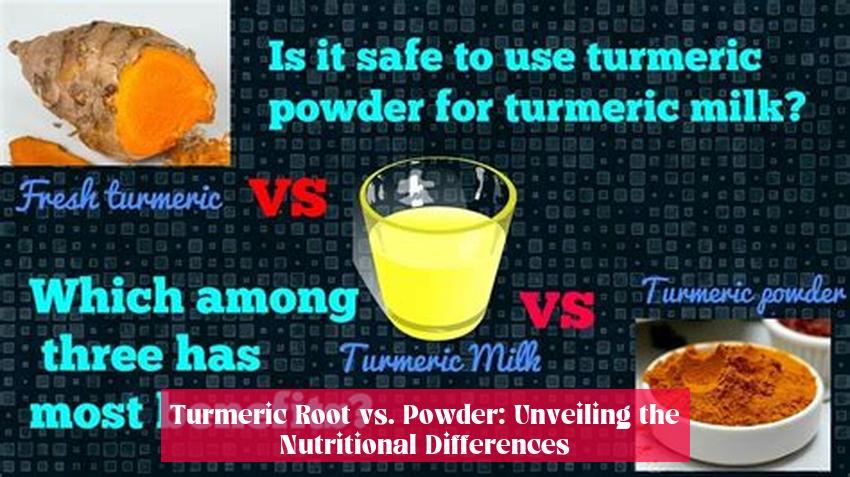Unveiling the Nutritional Powerhouse: Turmeric Root vs. Powder
Are you ready to spice up your knowledge on turmeric? Whether you’re a culinary whiz or a health enthusiast, the debate between turmeric root and powder is bound to pique your interest. From unraveling the nutritional differences to exploring the health benefits, we’re about to embark on a flavorful journey. So, grab your spice jars and get ready to uncover the secrets of this golden wonder!
Key Takeaways
- Raw turmeric root has a higher concentration of curcumin, making it more potent in terms of health benefits compared to turmeric powder.
- The best substitute for fresh turmeric root is turmeric powder, with a conversion ratio of approximately 1 teaspoon of turmeric powder for every one inch of fresh turmeric root.
- It’s believed that nutrients of raw turmeric root are better absorbed by the body than their dried forms, making it a preferable choice for consumption.
- Turmeric is best absorbed when taken with fatty foods, such as eggs and vegetable oils, as they contain a compound called lecithin which helps the body absorb turmeric.
- Fresh turmeric root contains more moisture and fiber, while the powdered version has a higher concentration of curcumin.
- Raw turmeric root and turmeric powder are two forms of the same ingredient, with raw turmeric boasting higher curcumin content and essential oils.
Table of Contents
Turmeric Root vs. Powder: Unveiling the Nutritional Differences

Turmeric, a vibrant yellow spice, has gained immense popularity for its medicinal properties. Derived from the root of the Curcuma longa plant, turmeric is available in two primary forms: fresh root and powder. While both forms offer health benefits, understanding their distinct characteristics is crucial for optimal utilization.
Turmeric root, also known as “kacchi haldi,” is the raw, unprocessed form of turmeric. It possesses a higher concentration of curcumin, the active compound responsible for turmeric’s anti-inflammatory and antioxidant properties. Additionally, fresh turmeric contains essential oils that contribute to its distinct aroma and flavor.
In contrast, turmeric powder is made from dried and ground turmeric root. It boasts a more concentrated form of curcumin, making it a potent choice for culinary and medicinal purposes. However, the drying process may result in the loss of some essential oils and other volatile compounds found in fresh turmeric.
In terms of nutritional value, fresh turmeric root contains more moisture and fiber compared to the powdered version. This makes fresh turmeric a good source of dietary fiber, which is essential for digestive health and satiety.
Health Benefits of Turmeric Root and Powder
Both turmeric root and powder offer a wide range of health benefits, primarily attributed to their high curcumin content. Curcumin possesses potent anti-inflammatory and antioxidant properties, making it effective in managing various health conditions.
Studies have shown that turmeric can alleviate symptoms of osteoarthritis and rheumatoid arthritis by reducing inflammation and pain. Its antioxidant properties protect cells from damage caused by free radicals, contributing to overall health and well-being.
Turmeric has also been found to have potential benefits in improving cognitive function, reducing the risk of cardiovascular diseases, and supporting liver health. However, it’s important to note that most research has been conducted using turmeric extracts or supplements, and more studies are needed to confirm the exact benefits of consuming turmeric in its natural form.
Unlocking the Power of Turmeric: A Natural Remedy for Blood Pressure Control
Choosing the Right Form of Turmeric
The choice between turmeric root and powder depends on individual preferences and intended use. If you prioritize the highest concentration of curcumin, turmeric powder is the better option. It is more potent and convenient to use in cooking or as a supplement.
However, if you seek the complete nutritional profile of turmeric, including essential oils and fiber, fresh turmeric root is the preferred choice. It is ideal for adding flavor and color to dishes, and it can be juiced or grated into smoothies and other beverages.
Incorporating Turmeric into Your Diet
Turmeric can be incorporated into your diet in various ways. Fresh turmeric root can be sliced, grated, or juiced and added to curries, stir-fries, and other dishes. Turmeric powder can be used as a spice in both savory and sweet preparations, and it can be added to smoothies, soups, and even baked goods.
For optimal absorption of curcumin, it is recommended to consume turmeric with fatty foods, such as eggs, avocado, or coconut oil. This is because curcumin is a fat-soluble compound, and fat helps the body absorb it more effectively.
Also read Big Round Root Vegetables: A Comprehensive Guide to Nutrition, Culinary Uses, and Growing Tips
Conclusion
Turmeric root and powder are versatile ingredients that offer a multitude of health benefits. Understanding their distinct characteristics and choosing the right form based on your needs will allow you to harness the full potential of this ancient spice. By incorporating turmeric into your diet regularly, you can enjoy its anti-inflammatory, antioxidant, and other health-promoting properties.
Read : Turmeric Root: Where to Buy and How to Choose the Best Quality
1. What are the primary forms of turmeric available?
Turmeric is available in two primary forms: fresh root and powder.
2. What are the differences between turmeric root and powder?
Turmeric root, also known as “kacchi haldi,” is the raw, unprocessed form of turmeric, while turmeric powder is made from dried and ground turmeric root.
3. Which form of turmeric has a higher concentration of curcumin?
Fresh turmeric root has a higher concentration of curcumin, the active compound responsible for turmeric’s anti-inflammatory and antioxidant properties.
4. What are the nutritional differences between fresh turmeric root and turmeric powder?
Fresh turmeric root contains more moisture and fiber compared to the powdered version, making it a good source of dietary fiber essential for digestive health and satiety.
5. What are the health benefits of turmeric root and powder?
Both turmeric root and powder offer a wide range of health benefits, primarily attributed to their high curcumin content, which possesses potent anti-inflammatory and antioxidant properties.
6. Can turmeric powder be used as a substitute for fresh turmeric root?
Yes, the best substitute for fresh turmeric root is turmeric powder, with a conversion ratio of approximately 1 teaspoon of turmeric powder for every one inch of fresh turmeric root.
7. How can turmeric be best absorbed by the body?
Turmeric is best absorbed when taken with fatty foods, such as eggs and vegetable oils, as they contain a compound called lecithin which helps the body absorb turmeric.














